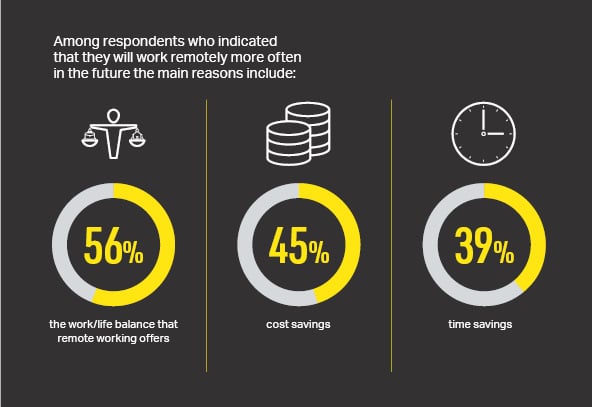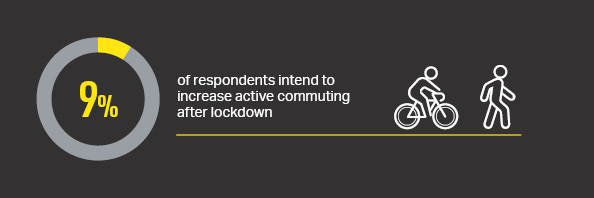Workforce mobility: what changed travel patterns mean for the office of the future
The Future of Infrastructure
Around the world, the coronavirus pandemic has had a huge effect on the way people travel, with a knock-on impact on where people and organisations work. As a result, many companies are in the process of assessing their real estate strategy. AECOM’s Elaine Brick and Arnis Kakulis take a look at emerging patterns of travel behaviour in Ireland and elsewhere to see what this might mean for the office of the future.
To understand the trends that are shaping the future of transport and workforce mobility, AECOM commissioned Interactions to survey a representative sample of the Irish population who had been engaged in employment or study prior to the pandemic. The findings echo surveys in London and elsewhere which indicate that particularly for office workers, travel habits have changed for good due to three main factors.
Firstly, barriers to remote working have been removed for many workers, and many will continue to work at home for at least part of the week even when the coronavirus pandemic is over. This will impact travel patterns.
Secondly, with the possibility of further pandemics or additional waves of infection related to the current pandemic, businesses may need to rethink working practices to avoid the rush-hour commute.
Thirdly, when they do have to commute, people with the option to do so are looking to sustainable modes of travel that can maximize social distancing such as walking and cycling – and space should be made for them to do so.
1/The remote working revolution
Although home working was on the increase before coronavirus, barriers such as organisational culture and IT policy meant many people trekked to the office to do work that could as easily have been done at home. In response to the coronavirus pandemic, lifestyle and working practices changed overnight for most office workers. The removal of these barriers has clear implications for traditional commuting patterns and office occupancy.
The scale of the shift is as yet unknown, however indications suggest home working could account for one, two or more working days per week. Global Workplace Analytics (GWA) estimates that we will see 25‐30 per cent of the workforce working at home on a multiple‐days‐a‐week basis within the next two yearsWorking from home after COVID-19: our forecast
.
Other surveys suggest home working could be higher in places. A July poll by Transport for London shows 72 per
cent of business respondents expect to implement increased working from home, with 65 per cent planning staggered times to avoid the busiest travel times as part of the re-occupancy of their offices. Surveys also show that the majority of employees want remote working policies expanded.

Reasons for wanting to work remotely in the future
(Source: AECOM Ireland survey)
Our Ireland survey shows 69 per cent of all respondents saying they would like to work remotely either regularly or occasionally in the future. This is particularly true among workers in the top socio-economic groups which are more likely to have professional services or office jobs that are conducive to working from home, whereas lower wage earners may be “essential” workers in grocery stores, and factories.
Prior to lockdown, 65 per cent of Irish respondents had never worked from home before. Among this group, 79 per cent would like to work remotely more in the future. Reasons include work/life balance (56 per cent), cost savings (45 per cent) and time savings (39 per cent).
Of course, some people need or want to work in a designated workspace. Among the 31 per cent of respondents who do not wish to or cannot work remotely in the future, over half are manual workers. Other reasons include the need for face-to-face interaction (17 per cent), employer requirements (15 per cent), and too many distractions at home (14 per cent). Wellbeing and personal connections are also suffering, particularly among the younger generation.
what this means
The shift to more flexible working patterns could reap significant benefits – environmentally, socially and economically. Less travel means less congestion, with associated time saving and emissions benefits. Another benefit comes by expanding the geographic sphere of work, enabling greater regional balance.
While reducing work commute trips is benefiting the environment, removing people from workplaces in their entirety is detrimental to morale and social connection. Going forward, the office will remain a critical driver of company culture, learning and connections and to sustain remote working over the longer-term, good digital connectivity is key. Employers might want to consider a remote working policy including guidelines for employers and a package of incentives for both employers and employees. Considering the work-related emissions of this move employers might consider subsidising the installation of solar panels at these workers’ homes instead of offering a company car as a benefit, for example.
For their part, public sector organisations should set an example for remote working practices. Some local authorities might want to consider encouraging investment in remote working centres. Such places would combine facilities for travel with a space that allows people to work and interact socially with colleagues.
2/avoiding the rush hour commute
The heavy congestion on public transport previously seen in peak hours is now unattractive in view of increased awareness of spatial safety and the need for social distancing. As well as more flexible working, the TfL survey showed 65 per cent of respondents expect staggered work times to ease demand for public transport at peak times, with 72 per cent saying that employees would be encouraged to travel outside peak periods getting to and from work and to use sustainable transport where possible.
The findings of our Irish research echo TfL’s. They show confidence in public transport as a means of commuting is threatened with 54 per cent of those who took public transport to work before the lockdown intending to change to their travel mode in the future.
what this means
Historically, public transport has been vital to the economic and social life of cities. In addition, there are important environmental, equity and safety issues if there is a permanent upturn in the use of private vehicles. To encourage a future shift back to mass transit systems, Irish respondents said they would like to see safety measures such as hand sanitiser provision (70 per cent), frequent vehicle cleaning (70 per cent), more use of contactless ticketing (69 per cent), more frequent services to reduce overcrowding (68 per cent), and widespread use of facemasks (60 per cent).
Interestingly, public health measures are now perceived as more important than cost in encouraging public transport use. Just 58 per cent of respondents suggested that a reduction in fares would encourage them to use public transport while only 45 per cent of respondents indicated that free public transport would encourage a future shift.
Agencies will have to build upon their existing systems and integrate new solutions to manage safety and improve the quality of the rider experience. Many of the technologies and solutions already exist and can be leveraged, such as automatic passenger counting, cameras, and touchless fare payment systems. However, an integrated and intelligent solution such as AECOM’s Transportation Resilient Integrated Passenger Solution (TRIPS) can make this process easier to manage and safer. TRIPS, launched in July this year, supports a safe return to service by leveraging new and existing technologies to inform transit riders’ decisions with real-time trip planning information, manage congestion at station platforms, control boarding and alighting, support safe arrival at the final destination and enable communication with operators and passengers.

Safety measures respondents said would encourage them to use public transport (Source: AECOM Ireland survey)
Behavioural change programmes can also help transport authorities to encourage more flexibility in working practices for the benefit of peak hour transport networks. In Singapore, a pilot programme for Travel Smart, designed and delivered by AECOM, focused primarily on reducing peak hour travel by working directly with major employers to introduce remote working and staggered working hours. The programme, which resulted in a 12 per cent reduction in peak hour travel, has now been expanded within Singapore to include 300 organisations. Similar programmes have been implemented in Australia and in London during the 2012 Olympic Games.
3/sustaining the increase in sustainable travel
There is an abundance of anecdotal evidence of a significant uptake in both walking and cycling during the pandemic. However, our survey findings suggest that there may be potential to sustain this with 9 per cent of respondents intending to increase active commuting after lockdown. This is supported by the Transport for London survey which showed 72 per cent of businesses planned to encourage employees to walk or cycle to work, or at least part way (68 per cent).
Our Irish survey showed the preference for active commuting is predominantly influenced by the desire to increase physical activity (35 per cent) but also by the perception that walking and cycling limit the perceived risk of close contact and therefore of contracting the virus (24 per cent).

Source: AECOM Ireland survey
what this means
Within the transport sector, there is a one-off opportunity to embrace recent commuting preferences to shape the future of our transport networks. Cities including Milan, Paris, New York, Seattle and London are investing in green infrastructure such as temporary cycle lanes and facilitating personal mobility, or are considering doing so. Some US cities are committing to permanently closing to traffic streets that have been car-free during the pandemic.
In Ireland, most cities are either not adapted to the physical spacing guidelines imposed by coronavirus or are not perceived as safe enough to attract inexperienced cyclists. The National Transport Authority and local authorities have commenced delivery of revised mobility plans for urban areas with the aim of encouraging people to return to city centres and in turn, aid economic recovery. A range of measures are being trialled such as extended or new pedestrianised areas, redistribution of road space to facilitate wider walking and cycling infrastructure, increased cycle parking, reduction in on-street parking, revised traffic management arrangements and road closures. Increased investment in the National Transport Authority Smarter Travel Workplaces programme, focusing on improved technology for challenges and monitoring, would encourage ongoing behavioural change. Financial support for the purchase of electric bicycles should be investigated, taking inspiration from cities such as Paris who have trialled such schemes.
Measures to reduce traffic speed should also be considered to ensure the safety of increased numbers of pedestrians and cyclists. From the employer side, workplace supports may be required to encourage the introduction of improved facilities such as secure bike storage, showers and lockers.
2021 and beyond
What this survey shows is that the future workplace is likely to evolve into a system of places, both physical and virtual. For some, the workplace will remain the principle location of work, but for others it will evolve. Functions such as sales, HR analytics, R&D, marketing, building services, engineering and real estate could benefit from a return to the office and the face-to-face interaction and creative collaboration that brings. Yet functions such as operations, legal, finance, customer service procurement, IT and admin could remain remote.
As we move around our different places of work – home, co-working spaces, regional satellite offices, company headquarters, community centres – employers will need to adapt. The first question for occupiers and developers is how much virtual working they want to embrace long term, and as a result, how much office space they need in future.
What is clear is that the role of the office is changing. In the future, the workplace will be about modularity and adaptability: spaces that do more than one thing.



